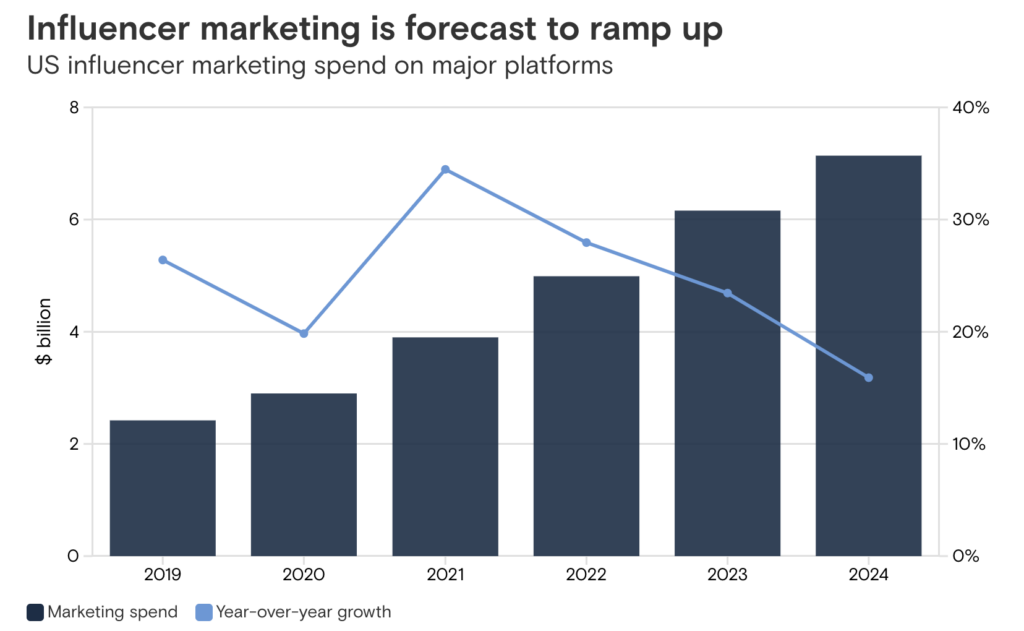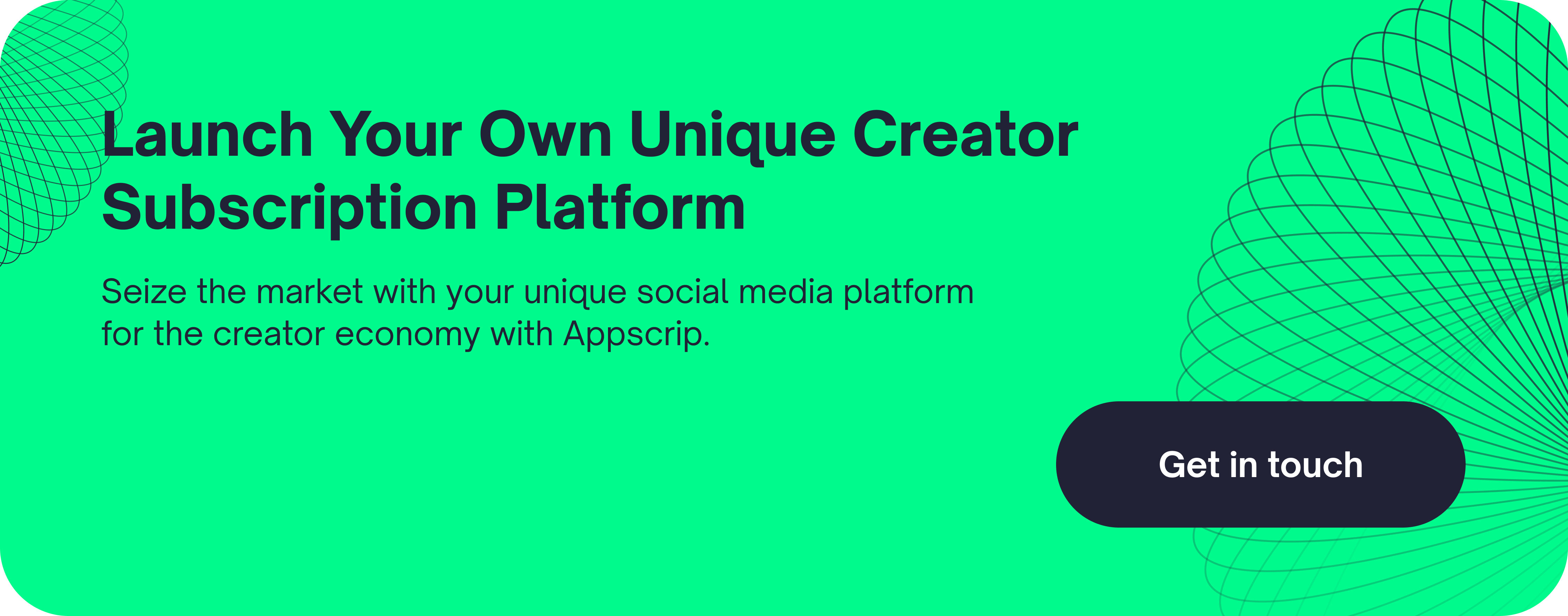Creators have unprecedented opportunities in today’s dynamic digital landscape to monetise their skills, knowledge, and content. The creator economy thrives on innovation and engagement, allowing individuals to turn their passions into lucrative revenue streams. We detail in this blog how do creators make money in the creator economy.
Rise of the Creator Economy
The Creator Economy has surged to prominence, revolutionising how individuals can generate revenue. This economy encompasses content creators, influencers, artists, writers, and more, who leverage digital platforms to share their expertise and creativity.
The Potential for Revenue Generation
The potential for revenue generation in the Creator Economy is vast. Through effective strategies, creators can turn their hobbies into sustainable income streams. Democratisation of content creation tools and the ability to connect directly with audiences have paved the way for unprecedented earnings.
Building a Strong Online Presence
Establishing a robust online presence is fundamental. This involves selecting appropriate platforms, optimising profiles, and crafting a consistent brand image. An engaging and professional online presence attracts and retains followers.
Developing a Personal Brand
A strong personal brand is a creator’s unique identifier. It encompasses values, style, while promising value to the audience. A compelling personal brand builds recognition and loyalty.
Crafting Your Unique Selling Proposition (USP)
Defining a clear USP is vital, this will give audiences a reason to engage. Creators need to identify what sets them apart – whether it’s their expertise, storytelling skills, or a unique perspective.
Consistent Branding Across Platforms
Consistency in branding across different platforms reinforces recognition. Uniform visuals, tone, and messaging create a cohesive identity that resonates with the audience.
Engaging with Your Audience Authentically
Authentic engagement fosters meaningful connections. Responding to comments, participating in discussions, and valuing feedback builds a loyal community.
How Do Creators Make Money
High-quality content is the cornerstone of the Creator Economy. Diverse content types cater to various audience preferences. Monetisation can occur through ads, sponsorships, and direct audience support.
Identify Your Niche and Target Audience
Focusing on a niche and understanding the target audience refines content and enhances engagement. Specialisation positions creators as authorities in their field.
Creating High-Quality and Diverse Content
Variety keeps audiences engaged. Creating diverse content, including videos, blogs, podcasts, and more, caters to different consumption preferences.
Leveraging Different Content Formats (Videos, Blogs, Podcasts)
Different content formats serve distinct purposes. Videos offer visual engagement, blogs provide in-depth analysis, and podcasts offer on-the-go learning. Leveraging each format widens your reach.
Implementing Effective SEO Strategies
Search Engine Optimisation (SEO) boosts discoverability. Researching relevant keywords and optimising content helps creators rank higher on search engines and drive organic traffic.

Leveraging Multiple Revenue Streams
Diversifying revenue streams mitigates risk. Relying on a single source is risky. Multiple streams include ads, sponsorships, merchandise sales, and more.
Diversify Income Channels
Exploring different platforms spreads risk and extends reach. Creator platforms, social media, and marketplaces offer various ways to monetise.
Subscription Models and Exclusive Content
Subscription models provide consistent income. Offering exclusive content to subscribers creates a sense of exclusivity, motivating support.
Crowdfunding and Fan Support Platforms
Crowdfunding platforms allow fans to directly fund creators. This financial support encourages creators to produce higher quality content.
Merchandising and E-commerce Ventures
Merchandising capitalises on brand loyalty. Selling branded merchandise or launching e-commerce ventures enhances revenue potential.
Sponsored Content and Brand Collaborations
Collaborating with brands aligns creators with revenue opportunities. However, maintaining authenticity is crucial to preserve credibility.
Intellectual Property Monetisation
Intellectual property (IP) monetisation involves capitalising on your unique creations. This includes selling licenses, products, or services that leverage your copyrighted materials, trademarks, and patents.
Licensing Your Content: Books, Courses, Artwork
Licensing your content enables you to expand your revenue streams. Convert your content into books, courses, artwork, or merchandise, offering audiences a chance to engage with your creations on multiple platforms.
Protecting Your Intellectual Property
Safeguard your creations by understanding copyright laws and trademarks. This protects your content from unauthorised usage and ensures that you maintain control over its distribution and monetisation.
Creating Membership Programs for Exclusive Offerings
Membership programs foster a sense of exclusivity among your audience. Offer premium content, early access, and exclusive perks to subscribers, creating a recurring revenue stream.
Data-Driven Decision Making
Base your strategies on data and insights. Monitor performance metrics, user behaviour, and engagement patterns to refine your approach.
Analyse Audience Insights
Gain deep insights into your audience’s preferences and behaviour. Understand what content resonates the most, allowing you to personalise your offerings accordingly.
Utilise Analytic Tools for Audience Insights
Leverage analytics tools to gather detailed audience data. Platforms like Google Analytics and social media insights provide valuable information about user demographics and engagement.
Understanding Demographics, Behaviour, and Preferences
Know your audience’s demographics, interests, and behaviours. This knowledge enables you to create content and offerings that cater to their specific needs.
A/B Testing for Optimisation
A/B testing involves comparing two versions of a particular element to see which performs better. Experiment with different content formats, titles, or pricing models to find what resonates with your audience.
Experimenting with Different Monetisation Strategies
Explore diverse monetisation strategies to find the most effective ones for your niche. This might include advertising, sponsored content, affiliate marketing, or direct sales.
Adapting Based on A/B Test Results
Let A/B test results guide your decisions. If one strategy consistently outperforms another, adjust your approach accordingly to maximise revenue.
Building Strong Relationships
Forge genuine connections with your audience. Respond to comments, engage in conversations, and show appreciation for their support.
Foster Community Engagement
Create a sense of belonging by fostering active engagement within your community. Encourage discussions, ask for feedback, and make your audience feel valued.
Build a Loyal and Engaged Online Community
Cultivate a loyal fan base by consistently delivering high-quality content that addresses their needs and interests.
Hosting Live Q&A Sessions, Webinars, or Workshops
Interact directly with your audience through live sessions. Offer insights, answer questions, and provide valuable experiences that can be monetised.
Encourage User-Generated Content and Participation
Involve your audience in content creation. Encourage them to share their creations, testimonials, and stories related to your brand, fostering a deeper sense of connection.
Collaborating with Others
Collaboration is at the heart of the creator economy. By joining forces with other creators, individuals can tap into new perspectives, skills, and audiences. Find partners whose values, content, and goals align, ensuring a mutually beneficial and successful collaboration.
Partnering with Other Creators for Cross-Promotion
Cross-promotion is wherein creators’ team up to promote each other’s content, products, or services. This strategy enables creators to tap into each other’s audiences, exposing their content to a wider and potentially more engaged demographic.
Joint Ventures and Co-Creation Projects
Taking collaboration, a step further, joint ventures and co-creation projects involve creators combining their expertise to develop something entirely new. This could range from co-authoring an e-book to designing a limited-edition product line.
Sharing Audiences to Expand Reach
When two or more creators collaborate, they introduce their respective audiences to each other’s content. This sharing of audiences allows creators to reach individuals who might not have discovered their content otherwise.
Long-Term Sustainability
Achieving enduring success demands a focus on long-term sustainability. Creators should resist the temptation of chasing short-term gains and instead prioritise building a solid foundation for their brand.
Consistency and Adaptability
The balance between consistency and adaptability is crucial. Maintaining a regular content schedule helps retain your audience’s interest, but staying adaptable enables you to incorporate new trends and adjust to changing preferences.
Stay Consistent in Your Content Delivery
Consistency in content delivery establishes expectations and builds trust. Whether it’s a weekly video, daily blog post, or regular podcast episode, a reliable schedule keeps your audience engaged and coming back for more.
Adapting to Industry Trends and Changes
The Creator Economy is dynamic, with trends evolving rapidly. Creators should stay attuned to industry shifts and incorporate relevant changes into their content strategy. Embracing emerging platforms and technologies can broaden your reach and revenue potential.
Being Open to Pivot While Staying True to Your Brand
Pivoting your content direction is sometimes necessary, but it should always align with your brand identity. Strive for a balance between innovation and maintaining the essence that attracted your audience in the first place.
Financial Management and Investment
Managing your finances wisely is paramount. Budgeting, tracking expenses, and diversifying income streams can provide stability. Consider smart investments that align with your brand and values.
Managing Your Earnings and Taxes Efficiently
Tax implications in the Creator Economy can be complex. Engage with financial experts to ensure you’re compliant and optimising your tax strategy.
Investing in Skill Development and Resources
Whether it’s improving your writing, video editing, or graphic design skills, continuous learning enhances your content’s value.
Building Emergency Funds for Stability
Financial stability ensures you can weather lean periods without compromising your content or brand.
Conclusion: How do creators make money
In the ever-evolving landscape of the Creator Economy, where individuals are monetising their skills and content creation, enhancing revenue requires a thoughtful approach. To navigate this dynamic environment successfully and achieve long-term financial growth, creators must consider key strategies as detailed above.
As the Creator Economy continues to flourish, these strategies serve as a roadmap to enhance revenue and build a sustainable, successful brand. By prioritising long-term sustainability, remaining consistent yet adaptable, and embracing financial prudence, creators can navigate this exciting landscape with confidence.

After an Engineering degree and a Diploma in Management I devoted 16+ years working in the automotive industry. My innate skill and extreme passion in writing, encouraged me to adopt it up as a profession. I have been writing for more than 10+ years in the software industry. The 400+ blogs I published are informative, exhaustive and interesting to a professional and causal reader.








